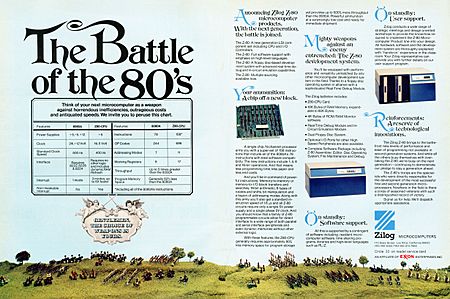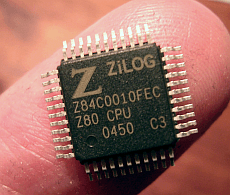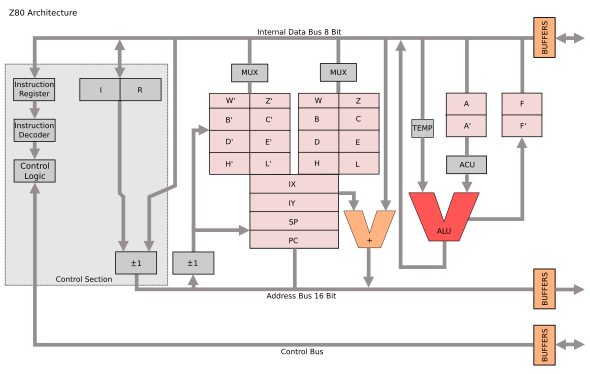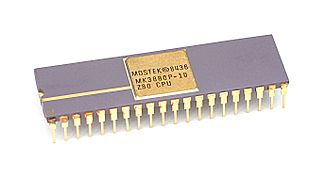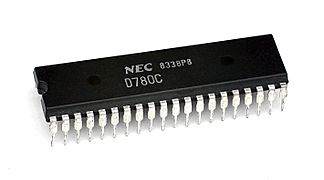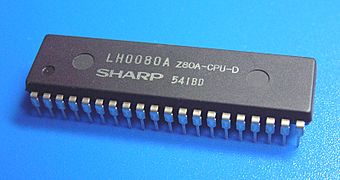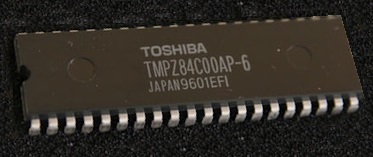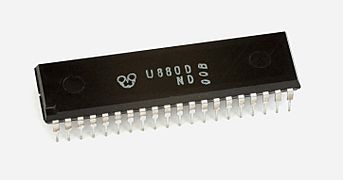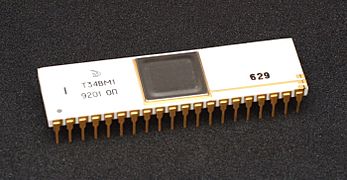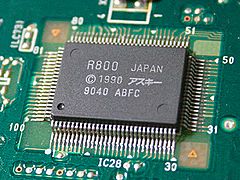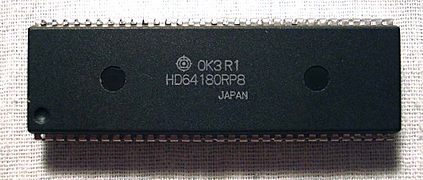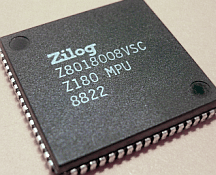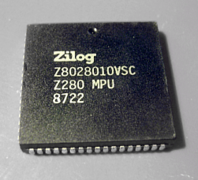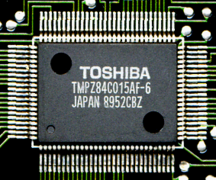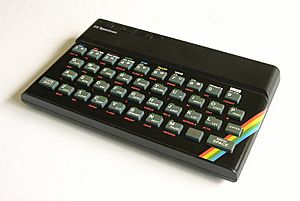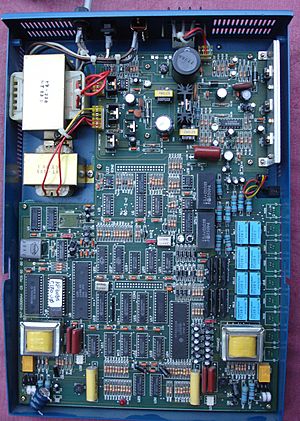Zilog Z80 facts for kids
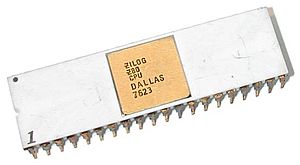
A Z80 manufactured in June 1976 according to the date stamp
|
|
| Produced | March 1976 |
|---|---|
| Designed by | Federico Faggin, Masatoshi Shima |
| Common manufacturer(s) | |
| Max. CPU clock rate | 2.5, 4, 6, 8 MHz to 10 MHz with CMOS variant up to 20 MHz and binary compatible derivatives (from Zilog) up to 33 and 50 MHz |
| Instruction set | Z80 |
| Predecessor |
|
| Successor |
|
| Socket(s) |
|
| Package(s) |
|
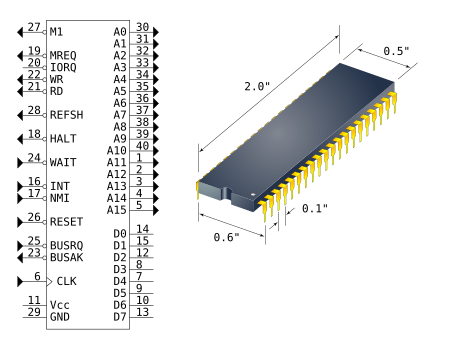
The Z80 is a special type of computer brain, called an 8-bit microprocessor. It was the very first product from a company called Zilog. Federico Faggin started thinking about the Z80 in late 1974. He and his team began developing it in early 1975.
The first working Z80 chips were ready in March 1976. It was officially launched in July 1976. The money Zilog earned from the Z80 helped the company build its own chip factories. Zilog grew to have over a thousand employees in just two years.
The Zilog Z80 was designed to work with software made for the Intel 8080. It was also improved with new features. Like the 8080, it was mainly made for embedded systems. These are computers hidden inside other devices. But the Z80 also became very popular in desktop computers and home computers. This was from the 1970s to the mid-1980s.
You could also find the Z80 in military devices and musical equipment. Famous examples include synthesizers like the Roland Jupiter-8. It was also used in many coin-operated arcade games. One very famous game that used the Z80 was Pac-Man.
Zilog allowed other companies to make the Z80. These included Mostek and Synertek in the US, and SGS in Europe. Many Japanese, East European, and Soviet companies also copied its design. This helped the Z80 become popular worldwide. Big companies like NEC, Toshiba, Sharp, and Hitachi started making Z80 chips or their own versions.
Today, Zilog focuses on embedded systems. Their newest Z80-compatible chip is the eZ80. It's a powerful 24-bit chip with a large address range. It works alongside simpler Z80 and Z180 products.
Contents
How the Z80 Was Made
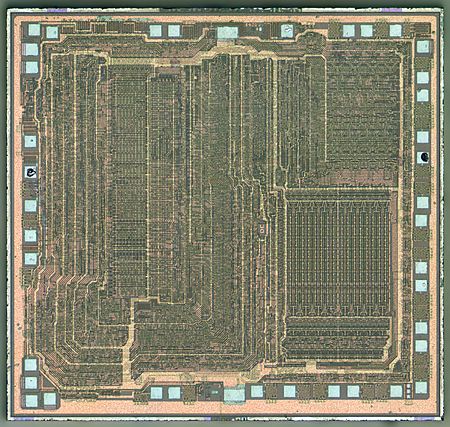
Starting Zilog
Physicist and engineer Federico Faggin used to work at Intel. He designed microprocessors there. He helped create the Intel 4004 and the Intel 8080. Masatoshi Shima was also a key designer for these chips.
In 1974, Intel saw microprocessors as a way to sell other products. Faggin felt restless and decided to start his own company. He teamed up with Ralph Ungermann. Shima also joined them later in February 1975.
Their new company, which didn't have a name yet, first planned to make a simple chip. But they soon realized it would be too expensive to compete. So, they decided to make a more complex microprocessor instead. They called it the Super 80. This new chip was designed to be compatible with the Intel 8080. But it would also add cool features from other chips, like the Motorola 6800.
Getting Funding and a Name
News about their new company spread. This caught the eye of Exxon Enterprises, a part of Exxon that invested in new technology. In June 1975, Exxon gave the company $500,000 to get started.
With funding secured, Shima began designing the chip in detail. He added a special feature: two sets of processor registers. These would help the chip respond quickly to interrupts (signals that tell the CPU to stop what it's doing and do something else).
The first design was ready by April 1975. The final design was completed in November. Faggin then looked for a company to produce the chips. Mostek agreed to make the Z80 chips for Zilog.
Faggin and Ungermann struggled to find a good name for their company. They were thinking about "integrated logic." Ungermann suggested "Zilog," and Faggin loved it. They thought it sounded like "the last word in integrated logic."
Making the First Chips
The first Z80 samples arrived from Mostek on March 9, 1976. Zilog officially launched the Z80 in July 1976. One of the first buyers worked for NEC, a Japanese company. Zilog had worried about other companies copying their design. Shima had secretly added "traps" to the chip. These traps made it harder to copy. An engineer from NEC later said the traps delayed their copying efforts by six months.
The Z80's success allowed Zilog to build its own chip factory. This helped them sell most of the Z80 chips. Mostek also started selling their own versions, called the MK3880. Having a second company make the chip was important. It meant customers wouldn't be stuck if Zilog, a new company, went out of business.
Z80 vs. Intel 8080
The Z80 was designed to be able to run most programs made for the Intel 8080. This included the CP/M operating system. Federico Faggin designed the instruction set (the commands the CPU understands). Masatoshi Shima designed most of the chip's inner workings. Faggin was also very involved in the chip's physical layout. He worked very long hours to meet deadlines.
The Z80 had many improvements over the 8080:
- More Commands: It had an improved set of instructions. These included easier-to-understand names for commands.
- Better Data Movement: It could move 16-bit data more flexibly.
- New Addressing: It had new ways to access memory and input/output devices. This included single-bit addressing.
- Index Registers: It added new IX and IY index registers. These helped access data in specific locations.
- Improved Interrupts: It had a better interrupt system. This included a non-maskable interrupt (NMI) for urgent events.
- Duplicate Registers: It had a full set of duplicate registers. The processor could quickly switch between them. This made it faster to respond to interrupts or handle multiple tasks.
- Simpler Hardware: It needed less external hardware.
- Single Power Supply: The Z80 needed only a single 5-volt power supply. The 8080 needed three different voltages.
- Single-Phase Clock: It used a simpler clock signal.
- Built-in Memory Refresh: It had a built-in feature to refresh DRAM memory. This saved space and cost.
Z80's Market Success
The Z80 quickly became one of the most popular 8-bit CPUs. It took over from the 8080 and its updated version, the 8085. Some companies, like British Telecom, kept using the 8085 for certain devices. But many others switched to the Z80.
Some computers even used the Z80 alongside other CPUs. Examples include the Radio Shack TRS-80 Model 16 (with a Motorola 68000) and the Commodore 128 (with a MOS 8502).
Later, Zilog made a low-power Z80. This was perfect for the growing laptop computer market in the early 1980s. CMOS versions of the Z80 (from Zilog and Japanese companies) became very popular in portable devices. Examples include the Amstrad NC100 and Cambridge Z88.
One reason for the Z80's success was its built-in DRAM refresh. This was helpful for computers running CP/M. Another reason was its simple interrupt system. These features allowed computers to be built with fewer parts and simpler designs.
The Z80's speed also increased over time. The first Z80 ran at 2.5 MHz. Later versions reached 4 MHz (Z80A), 6 MHz (Z80B), and 8 MHz (Z80H). CMOS versions can run up to 20 MHz today. Newer Z80-compatible chips, like the HD64180/Z180 and eZ80, can reach 33 and 50 MHz.
How the Z80 Works Internally
Programming Model and Registers
The Z80's internal design is based on earlier chips like the Datapoint 2200 and Intel 8080. It uses special storage areas called registers to hold data and addresses.
The Z80 improved on the 8080's registers. It made all 16-bit register pairs more flexible. It also added two new 16-bit registers, IX and IY. These are mainly used as base addresses. This means you can add a small number (offset) to them to find data.
The Z80 also has a duplicate set of registers. This "alternate register set" can be quickly swapped with the main set. This is very useful for handling interrupts quickly. For example, when a printer needs attention, the CPU can switch to the alternate registers. It handles the printer, then switches back to its main task without losing its place.
Registers Explained
|
||||||||||||||||||||||||||||||||||||||||||||||||||||||||||||||||||||||||||||||||||||||||||||||||||||||||||||||||||||||||||||||||||||||||||||||||||||||||||||||||||||||||||||||||||||||||||||||||||||||||||||||||||||||||||||||||||||||||||||||||||||||||||||||||||||||||||||||||||||||||||||||||||||||||||||||||||||||||||||||||||||||||||||||||||||||||||||||||||||||||||||||||||||||
The Z80 uses 8-bit registers that can be paired to form 16-bit registers. The main registers, similar to the 8080, are:
AF: Holds the 8-bit accumulator (A) and flag bits (F). Flags tell the CPU about the results of operations (e.g., if a result was zero).BC: A 16-bit register, or two 8-bit registers (B and C). Used for data or memory addresses.DE: Another 16-bit register, or two 8-bit registers (D and E). Also used for data or memory addresses.HL: A 16-bit register, or two 8-bit registers (H and L). Used for data, addresses, or calculations.SP: The stack pointer, a 16-bit register. It points to a special area of memory called the "stack."PC: The program counter, a 16-bit register. It always points to the next instruction the CPU needs to run.
New registers in the Z80 are:
IXandIY: These are 16-bit index registers. They are great for accessing data that is organized in lists or structures.I: The interrupt vector base register (8 bits). It helps the CPU find the right program to run when an interrupt happens.R: The DRAM refresh counter (8 bits). This register helps keep dynamic RAM (DRAM) working correctly by refreshing it. It can also be used for other creative purposes, like generating random numbers.AF',BC',DE',HL': These are the alternate (or shadow) registers. They are copies of the main registers. The CPU can quickly switch between the main and alternate sets.
Z80 Assembly Language
Assembly language is a low-level programming language. It uses short words (mnemonics) to represent machine code instructions. The Z80 has its own assembly language.
The Z80's assembly language is more organized than the Intel 8080's.
- All registers are called by their full names.
- Parentheses `()` are used to show "memory contents at." For example, `(HL)` means the data stored at the memory address held in the HL register.
- Most commands, like `LD` (for LOAD), `ADD`, and `INC` (for increment), use the same name. This makes the language easier to learn.
The Z80 also added new types of instructions. These include:
- Block Transfer: Commands like `LDIR` can copy large blocks of data very quickly.
- Bit Manipulation: Instructions to set, reset, or test individual bits within a byte.
- Relative Jumps: Commands like `JR` allow the program to jump to a nearby address. This is useful for loops and saving code space.
Z80 Clones and Newer Versions
Other Companies Making Z80s
Many companies made their own versions of the Z80. This is called "second-sourcing."
- Mostek made the MK3880.
- SGS-Thomson made the Z8400.
- Sharp and NEC made the LH0080 and μPD780C. These were used in many Japanese home computers.
- Toshiba made a CMOS version, the TMPZ84C00.
- In East Germany, an unlicensed copy called the U880 was made. It was used in many computers there.
- The Soviet Union also made Z80 clones, like the T34BM1.
Newer Z80-Based Chips
Over the years, Zilog and other companies created more advanced chips based on the Z80.
- The Hitachi HD64180 (later Zilog Z180) added more features and could address more memory (1 MB).
- The Zilog Z380 (1994) is a 32-bit Z80-compatible chip. It's mainly used in phone equipment.
- The eZ80 (2001) is a very fast, modern Z80-compatible chip. It can run instructions much faster than the original Z80. It's used in many embedded systems today.
- The National Semiconductor NSC800 (1980) was fully compatible with the Z80's instructions.
Where the Z80 Was Used
Desktop Computers
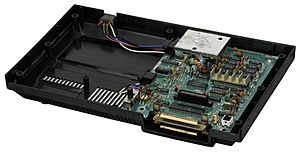
In the late 1970s and early 1980s, the Z80 was very popular in business computers. These computers often ran the CP/M operating system. Famous examples include the Osborne 1 (a portable computer) and the Kaypro series.
Many home computers also used the Z80 as their main processor. The TRS-80 series was very well-known. Other computers, like the DEC Rainbow 100, used both an Intel 8088 and a Z80. This allowed them to run software made for either chip.
In 1981, Multitech (now Acer) made the Microprofessor I. This was a simple and cheap system to learn about the Z80. It's still made and sold today!
Portable and Handheld Devices
The Z80 became popular in lighter, battery-powered devices. This was thanks to the new CMOS versions of the chip.
- The Sharp PC-1500 (1981) was a BASIC-programmable pocket computer.
- Later, Sharp Wizard organizers used Z80 chips.
- Laptops running CP/M, like the Epson PX-8 Geneva (1984), also appeared.
- Even as newer chips came out, Z80-based systems were still made for their long battery life. Examples include the Cambridge Z88 (1988) and the Amstrad NC100 (1992).
- The Cidco MailStation Mivo 100 (1999) was a portable email device with a Z80 inside.
- Texas Instruments used Z80-based chips in their TI-8x series of graphing calculators. These started with the TI-81 in 1990. Many TI-8x calculators still use Z80 or eZ80 chips today, like the TI-84 Plus CE series.
Embedded Systems and Electronics
The Zilog Z80 is still widely used in embedded systems. These are computer systems built into other devices. You can find Z80s in:
- Consumer Electronics: Many everyday devices.
- Industrial Products: Machines used in factories.
- Musical Instruments: The Z80 was in the famous Prophet-5 synthesizer. It was also in the first MIDI synthesizer, the Prophet 600.
- Video Games: Many early 1980s arcade games, including Pac-Man, used Z80 CPUs. The Sega Master System and Game Gear consoles also used the Z80. The Sega Genesis console even had a Z80 alongside its main CPU. It helped with sound and backward compatibility.
In the late 1980s, some Soviet landline phones used the Z80. These phones had features like caller ID and speed dial.
Images for kids
See also
 In Spanish: Zilog Z80 para niños
In Spanish: Zilog Z80 para niños
- Zilog eZ80
- S-100 bus
- SymbOS
- Z88DK
- Micro-Professor MPF-I, Z80 training system


